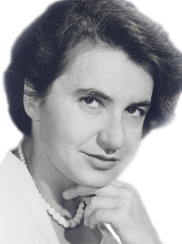![]() If you are reading this, then the chances are you have an internet-enabled computer. And if you have an internet-enabled computer, then in all probability (in the hope that you are not a Bing-ling) you know that today would have been Rosalind Franklin's 93rd birthday – thanks to Google's doodle.
If you are reading this, then the chances are you have an internet-enabled computer. And if you have an internet-enabled computer, then in all probability (in the hope that you are not a Bing-ling) you know that today would have been Rosalind Franklin's 93rd birthday – thanks to Google's doodle.
 At Genome Biology, we find it heartening that Google has chosen to use its immense public platform to spread the word about Franklin, the British scientist whose research at King's College London played a key part in Watson & Crick's determination of the structure of DNA, and her life's work.
At Genome Biology, we find it heartening that Google has chosen to use its immense public platform to spread the word about Franklin, the British scientist whose research at King's College London played a key part in Watson & Crick's determination of the structure of DNA, and her life's work.
Earlier this year, we interviewed Franklin's PhD student, Raymond Gosling, about the road to the double helix – part of our DNA60 coverage. Gosling was not only Franklin's collaborator in the DNA research, but was himself the first person to crystallize genes, before Franklin joined the project. In addition, the famous Photo 51, widely revered as the most wondrous image in the history of science, was taken by Gosling, although it is frequently (semi-erroneously) credited to Franklin.
 Gosling makes clear in his interview the invaluable contribution made by Franklin to the double helix discovery, in that her expertise was able to steer the King's team toward the production of high quality X-ray photographs where they had previously been fuzzy and indistinct. In particular, her careful preparation of DNA crystals at different humidities showed that DNA could exist in two forms, which should be studied separately in order to obtain optimal diffraction patterns. To view pictures of the original DNA samples used by Franklin and Gosling, please see our Photo 51 Flickr gallery.
Gosling makes clear in his interview the invaluable contribution made by Franklin to the double helix discovery, in that her expertise was able to steer the King's team toward the production of high quality X-ray photographs where they had previously been fuzzy and indistinct. In particular, her careful preparation of DNA crystals at different humidities showed that DNA could exist in two forms, which should be studied separately in order to obtain optimal diffraction patterns. To view pictures of the original DNA samples used by Franklin and Gosling, please see our Photo 51 Flickr gallery.
Alongside her skills as an experimental scientist, Gosling also pays tribute to Franklin's personal integrity. In recent years, much has been made of the obstacles faced by Franklin as a female in a male-dominated culture, and how sexism contributed to the friction between her and fellow DNA researchers Maurice Wilkins and Jim Watson. And yet she was nothing but magnanimous when beaten by Watson in the race to the double helix.
At the same time, Franklin was not intimidated by her male competitors, as exemplified by her reaction to Watson and Crick's initial model of DNA's structure, which was not only incorrect but contained a number of rudimentary errors. As retold beautifully by Gosling on our Biome podcast, Franklin verbally tore the model apart 'with relish'. Watson – perhaps for the only time in his life – was rendered speechless. But Franklin, as Gosling remembers it, 'was on the top of her form.'
Latest posts by Naomi Attar (see all)
- tRFs and the Argonautes: gene silencing from antiquity - 2nd October 2014
- Keeping up with the Jobses: the role of technology in reproducible research - 26th September 2014
- How to disarm a superbug – a story told by forensic genomics - 23rd June 2014
[…] If you are reading this, then the chances are you have an internet-enabled computer. And if you have an internet-enabled computer, then in all probability (in the hope that you are not a Bing-ling) you know that today would have been Rosalind Franklin's 93rd birthday – thanks to Google's doodle. […]
As she died at the age of 37,is “grand old lady” appropriate?
‘Grand old lady’ refers to Franklin’s 93rd birthday, which Google has chosen to celebrate, and is a mark of respect.
[…] the internet has been buzzing with posts about Rosalind Franklin (see, for example, posts on the BioMed Central blog or The Guardian), sparked off by a google doodle on her 93rd […]
[…] & Crick's model of DNA's double helix was based. Gosling had worked closely with Rosalind Franklin, whose contribution to the discovery is now rightly celebrated. However, he had initially been […]
[…] have inspired and brought changes not only in society but also in scientific endeavours, such as Rosalind Franklin who played a crucial role in the discovery of the DNA double […]